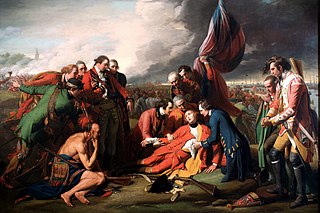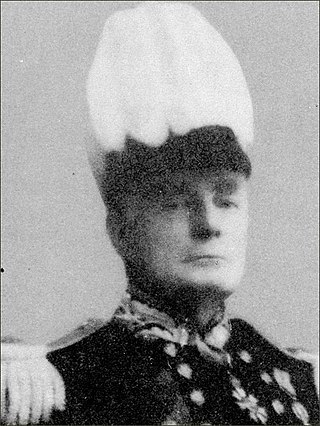Related Research Articles

Newfoundland and Labrador is the easternmost province of Canada, in the country's Atlantic region. The province comprises the island of Newfoundland and the continental region of Labrador, having a total size of 405,212 km2 (156,453 sq mi). As of 2024 the population of Newfoundland and Labrador was estimated to be 545,247. The island of Newfoundland is home to around 94 per cent of the province's population, with more than half residing in the Avalon Peninsula. Labrador shares a land border with both the province of Quebec and the territory of Nunavut on Killiniq Island. The French overseas collectivity of Saint Pierre and Miquelon lies about 20 km (12 mi) west of the Burin Peninsula.

Events from the year 1879 in Canada.
Whitbourne is a town on the Avalon Peninsula in Newfoundland and Labrador, Canada in Division 1.
Sir Richard Whitbourne was an English colonist, mariner and writer.

William Robertson Warren was a Newfoundland lawyer, politician and judge who served as the dominion's Prime Minister from July 1923 to April 1924.

Sir Charles Cavendish Boyle was a British civil servant, magistrate, and colonial administrator who served as Colonial Governor of Newfoundland, Mauritius and British Guiana. He wrote the lyrics for the anthem of the Dominion and later Province of Newfoundland, "Ode to Newfoundland".

Colonel Cluny Macpherson was a physician and the inventor of an early gas mask. After World War I he served as the president of the St. John's Clinical Society and the Newfoundland Medical Association.

The Telegram is a weekly newspaper published Fridays in St. John's, Newfoundland and Labrador, Canada, though now printed outside the province.

Sir Charles Alexander Harris was a British colonial administrator, Governor of Newfoundland from 1917 to 1922.
Helena Squires, née Strong was a Newfoundland politician born in Little Bay Islands.

The Anglican Church of Bermuda is a single diocese consisting of nine parishes and is part of the Anglican Communion, though not a part of an ecclesiastical province. The current Bishop of Bermuda, seated at the Cathedral of the Most Holy Trinity in the City of Hamilton, is Nicholas Dill, who was installed on 29 May 2013.

Leonard Tretheway Stick was a Liberal party member of the House of Commons of Canada. He was born in St. John's, Newfoundland and became an accountant, businessman, clerk and manager by career. Leonard Stick was the first Newfoundlander to enlist during World War I, following the creation of the Newfoundland Regiment in September 1914.
John Munn was a Scottish-born merchant and political figure in Newfoundland. He represented Conception Bay from 1842 to 1848 and Harbour Grace from 1869 to 1873 in the Newfoundland and Labrador House of Assembly as a Conservative.
William J. S. Donnelly was an author and political figure in Newfoundland. He represented Placentia and St. Mary's in the Newfoundland and Labrador House of Assembly from 1878 to 1889, from 1893 to 1894 and from 1897 to 1899 as a Liberal, then Reform and later as a Conservative.

The 1874 Newfoundland general election was held in 1874 to elect members of the 12th General Assembly of Newfoundland in the Colony of Newfoundland. The Conservative Party led by Frederick Carter formed the government.
The 1878 Newfoundland general election was held in 1878 to elect members of the 13th General Assembly of Newfoundland in Newfoundland Colony. The Conservative Party led by William Vallance Whiteway formed the government.

The 1873 Newfoundland general election was held in November 1873 to elect members of the 11th General Assembly of Newfoundland in the Colony of Newfoundland. The Anti-Confederates led by Charles Fox Bennett formed the government; a "new" Conservative party led by Frederick Carter formed the opposition.

The Anglican Diocese of Newfoundland was, from its creation in 1839 until 1879, the Diocese of Newfoundland and Bermuda, with the Cathedral of St. John the Baptist at St. John's, Newfoundland, and a chapel-of-ease named Trinity Church in the City of Hamilton in Pembroke Parish, Bermuda. Newfoundland and Bermuda had both been parts of British North America until left out of the 1867 Confederation of Canada. In 1842, her jurisdiction was described as "Newfoundland, the Bermudas". In 1879 the Church of England in the British Overseas Territory of Bermuda was created, but continued to be grouped with the Diocese of Newfoundland under the bishop of Newfoundland and Bermuda until 1919, when Newfoundland and Bermuda each received its own bishop.

The Newfoundland expedition was a series of fleet manoeuvres and amphibious landings in the coasts of Newfoundland, Labrador and Saint Pierre and Miquelon carried out by the combined French and Spanish fleets during the French Revolutionary Wars. This expedition, composed of seven ships of the line and three frigates under the orders of Rear-Admiral Richery sailed from Cadiz in August 1796 accompanied by a much stronger Spanish squadron, commanded by General Solano, which had the aim of escorting it to the coast of Newfoundland.
References
- 1 2 3 4 "Raftus, Richard". Encyclopedia of Newfoundland and Labrador . p. 507.
- 1 2 "Transcription". Harbour Grace Standard & Conception Bay Advertiser. September 13, 1879.